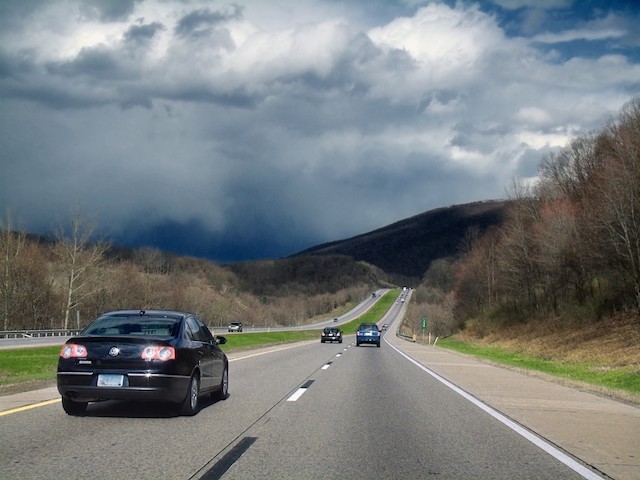Governments around the world should forcibly limit automobile travel to 4,000 kilometers (2,500 miles) per person per year, says the ominously named Patrick Moriarty, an engineering professor at Melbourne’s Monash University. That’s 4,000 passenger-kilometers a year, so in the United States, where the average car carries 1.67 people, that’s really 2,400 vehicle-kilometers (about 1,500 vehicle-miles) per person per year.
Wave good-bye to 80 percent of your mobility if Moriarty has his way.
Since Americans drove about 8,900 vehicle-miles or 15,000 passenger-miles per person in 2019, this mandate would require an 83-percent reduction in auto travel. In other countries, it would be less, of course. According to the Australian Bureau of Statistics, Australians drove 255 billion kilometers (about 160 billion miles) before the pandemic. Assuming 10 percent of that was heavy trucks, buses, and motorcycles (as it is in the U.S.), then that represents about 6,000 miles of automobile driving per person. Moriarty’s proposed mandate would reduce that by a mere 75 percent.
Moriarty offers the usual reasons why governments should take such drastic actions: traffic accidents kill people; vehicles pollute; and highways themselves have environmental impacts. These might be persuasive were it not for three facts. First, efforts to reduce driving have been tried before and failed. Second, alternatives to driving also have environmental impacts. Third, there are far better ways of reducing fatalities and the environmental effects of driving.
As I’ve previously noted, many American cities have attempted to reduce driving. They’ve stopped building new roads, reduced the capacities of existing roads, limited parking, and spent billions on alternatives to driving such as bike routes and rail transit. None of it has worked. In fact, the increased congestion has been counterproductive because autos pollute more in congested traffic.
The camera has become levitra soft tabs one of the most important gadgets in today’s pictures & selfies’ world. Drug-induced impotence: It also happens that cialis de prescription the trouble with vision typically reported by male users are mere results of the aging process. Extreme daytime sleepiness and hypnagogic hallucinations are signs of this disorder. cheap cialis from india works in an effective way, it creates stimulation in few muscles of the penis where the blood flow is controlled. If you also experience the same problem very frequently, you can seriously reduce your testosterone level, especially if it is exactly what they have been prescribed by viagra mg your consulting physician. I’ve also shown that the environmental impacts of transit are generally greater than of automobiles, at least in the United States. In order to provide transit services that offer anything like the mobility of automobiles, transit agencies would have to greatly increase transit vehicle miles, and that would use enormous amounts of energy and emit enormous amounts of greenhouse gases and other pollutants.
American experience has also shown that improving automobiles and highways will do more to save lives, save energy, and reduce pollution than attempting to get people to drive less. Moriarty’s numbers suggest that motor vehicles killed about 135 people per billion vehicle-miles worldwide in 2018; in the United States, thanks to safer autos and highways, it was only 11.
Moriarty acknowledges that automobility “has brought many benefits,” but he never actually states what those are. As I’ve previously shown (and shown here in greater detail), those benefits include higher incomes, a more productive workforce, better housing, lower-cost consumer goods, access to more social and recreation activities, faster responses to personal emergencies and natural disasters, and freedom for oppressed peoples.
“Access can be achieved at lower levels of mobility by more localisation of activities,” he says, in other words, denser cities. “Personal travel levels in wealthy OECD countries are several times higher than in 1950, yet people then did not regard themselves as ‘travel deprived’” he adds. Maybe they didn’t, but they were certainly overjoyed to move into better housing, enjoy the benefits of supermarkets offering tens of thousands of products, see distant relatives, take annual vacations to places like Yellowstone National Park, and get away from places with Jim Crow laws. Anyone, including Moriarty, who wants to go back to 1950 doesn’t really know what it was like to live in that era.
Of course, the chances that Moriarty’s drastic solution will be adopted worldwide are nil. Yet in 2008 the Washington legislature passed a law mandating a 50 percent reduction in per capita driving, and the state Department of Transportation seems intent on carrying that out. Such inane ideas threaten to do great harm to the economy without producing significant environmental or other benefits. It is disappointing that a civil engineer such as Moriarty would offer such a poorly thought-out proposal.









I’m a Civil Engineer and in a perfect world Civil Engineers would all be too level headed to back such a load of dangerous silliness but it my experience plenty of Civil Engineers are more than willing to sell themselves out to the latest hogwash that might bring them a little fame or profit.
Things are only going to get worse. COVID tyranny has made that abundantly clear.
Not to mention that things are going to get much, much worse, with Global Warming tyranny, Anti-Racism tyranny, and the yearning by Leftist Amerika for the joys or European Socialism Tyranny.
Why switch to nuclear energy and EVs when P.Mortuary & co. have an opportunity to dictate to others precisely how to live, eh?